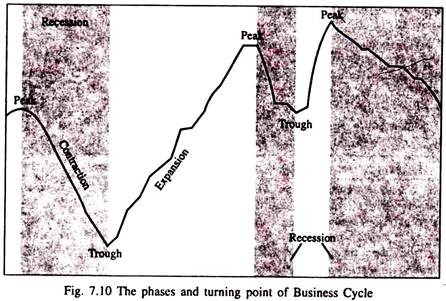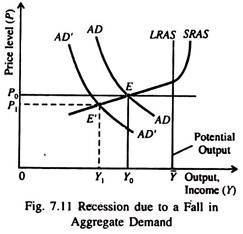Let us make an in-depth study of Business Cycle. After reading this article you will learn about: 1. Meaning of Business Cycles 2. Features of the Business Cycle 3. Business Cycles Theories.
Meaning of Business Cycles:
Short-run economic fluctuations (called business cycles) occur due to changes in AS or AD.
These curves shift due to exogenous changes, called shocks to the economy, which can be either favourable (beneficial) or adverse (harmful).
Such shocks are of two types: demand shocks (which shift the AD curve) and supply shocks (which shift the AS curve). AS and AD curves can be used to show how shocks cause business cycles by causing deviation of output and employment from their natural rates.
Features of the Business Cycle:
ADVERTISEMENTS:
Business cycles are economy-wide fluctuations in total national output, income, and employment, usually lasting for a period of 2 to 10 years, marked by widespread expansion
or contraction in the leading sectors of the economy. Business cycles are the irregular expansions and contractions in economic activity. They are the third component of time series, viz., cyclical fluctuations.
Typically economists divide business cycles in two main phases, recession and expansion. Peaks and troughs mark the turning points of the cycles. Fig. 7.10 shows the successive phases of the business cycle. The downturn of a business cycle is called a recession.
A recession is a recurring period of decline in total output, income, and employment, usually lasting from 6 months to a year and marked by widespread contractions in many sectors of the economy. A depression is a recession that is major — in both scale and duration.
Business Cycles Theories:
There are two components of any theory of business cycles — (i) the sources or the causes of business cycle and (ii) the propagation mechanism. Economists classify the different sources of business cycles into two categories exogenous and internal.
ADVERTISEMENTS:
The exogenous theories find the sources of the business cycle in the fluctuations of factors outside the economic system — in wars, revolutions, and elections; in oil prices, gold discoveries, and migrations; in discoveries of new lands and resources; in scientific breakthroughs and technological innovations; even in climatic change or the weather.
Demand-induced Cycles:
One important source of business fluctuations is shocks to aggregate demand. A typical case is illustrated in Fig. 7.11, which shows how a decline in aggregate demand lowers output from Y0 to Y1.
Here the economy begins in short-run equilibrium at point E. Then, perhaps because of a decline in defence spending or tight money, the aggregate demand curve shifts leftward to AD’. If there is no change in aggregate supply, the economy will reach a new equilibrium at point E’. In addition, prices (P1) are lower than they were at the previous equilibrium (P0), and the fate of inflation falls.
The case of a boom is, naturally, just the opposite. Here, the AD curve shifts to the right, output approaches potential GDP or perhaps even overshoots it, and prices and inflation rise.
Business-cycle fluctuations in output, employment, and prices are often caused by shifts in aggregate demand. These occur as consumers, businesses, or governments change total spending relative to the economy’s productive capacity.
When these shifts in aggregate demarid lead to sharp business downturns, the economy suffers from recessions or even depressions. A sharp upturn in economic activity can lead to inflation.

